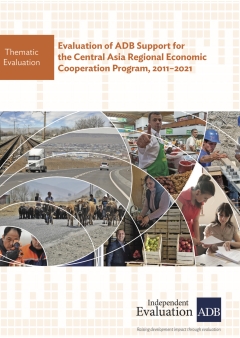
Evaluation of ADB Support for the Central Asia Regional Economic Cooperation Program, 2011–2022
The CAREC subregion is one of the least integrated in the world, with more difficult preconditions for RCI than other developing regions. It also has enormous potential for RCI, given its strategic location as a land bridge connecting some of the world’s largest economic centers, and the underdeveloped trade and economic links among CAREC member countries. The CAREC Program aims to accelerate growth and poverty reduction by supporting RCI to improve connectivity, economic competitiveness, and the provision of regional public goods.
The evaluation assesses ADB’s contribution towards achieving the CAREC Program’s objectives during 2011-2021. It found that ADB has made significant progress in helping improve connectivity in the subregion but contributed modestly to improving regional economic competitiveness, due to continuing challenges in removing barriers to trade. Except for some promising advancements in climate change mitigation in the energy sector, achieving outcomes of improved supply of regional public goods remains a long-term objective given that ADB’s support is still nascent and the continuing need for institution and consensus building. Overall, the CAREC Program has the generally appropriate institutional setup, strategies, and instruments to deliver its objectives. However, as the CAREC Program expands into new non-infrastructure sectors, and as the delivery of global and regional public goods such as climate change takes greater priority, ADB staff and technical assistance resources could face increased pressure.
To improve future performance, the evaluation highlights the importance of strengthening support for investment climate and trade policy reforms, modernization of border crossing points and customs processes, development of a multimodal corridor network, climate change mitigation and adaption, and better results monitoring.
